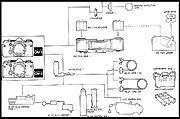ZUIKO Interchangeable Lenses (Delayed project..) One of many advantages of the single lens reflex type of camera is the large variety of interchangeable lenses available. Zuiko lenses, included in the Zuiko Interchangeable Lens Group of the OM System with those under development, have always enjoyed a high reputation in photographic circles - new design technology has made possible a new series of innovative, high performance lenses.
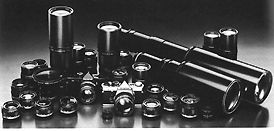 |
These lenses have a host of special features including a new construction that compensates for close focus aberrations, increased aperture ratio in the wide angle lenses, and reduction in telephoto lens size and weight.The OM System adopts 49mm filters for most lenses from 21mm to 200mm. As part of the OM System design all the lenses now offer higher performance in small configurations. OLYMPUS has produced lenses for microscopes for many years and the new Zuiko lenses benefit from this scientific experience. |
Accessories for Interchangeable Lens
Lens Filters In general or many specialized photographic
fields, filters are essential to the effective rendition of photographic subjects.
Whether in black and white or color, filters are necessary additions to most camera
systems. In controlling contrast and eliminating unwanted haze in black and white
photography, the use of the correct filter often means the difference between a good
photograph and a great one. In color, where the balancing of the light with the film
emulsion is absolutely necessary for correct color, conversion and light balancing
filters are the only effective way of achieving the desired results. * Be careful not to use two filters
simultaneously in order to avoid unintentional cut in the periphery of a photograph. Lens Hoods
Lens hoods
protect against extraneous light striking the lens and causing unwanted glare. Hoods
for standard lenses are cover types and can be reversed to provide easy storage even
when the camera is in the case.
Camera Body
Cap Rear
Lens Cap; Front Lens
Caps (49mm,
55mm, 72mm and 100mm in diameter)
Motor Drive Group * More detailed info is available Designed specifically to complement the OM Body, the Motor Drive Group has been reduced in size to enhance its maneuverability and ease of operation. Both the hand grip type motor drive and the control grip provide a built-in shutter release button so that the photographer can even handhold a 300mm telephoto lens for shooting sports or other action subjects. A 250 exposure roll film back and other units attach to the OM-2 without cords. This Motor Drive Group is also a convenient accessory when used with other groups for close-up, macrophotography, photomicrography, etc.
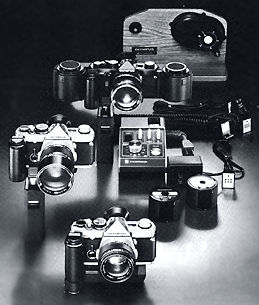 |
The Motor Drive Group consists of a number of units for sequential exposures in all types of photography. The basic combination is designed to be the smallest in the world. A remote control mechanism is also available for a series of exposures taken intermittently in conjunction with the M. AC Control Box, or a series of exposures with bulk films. |
Accessories for
Motor Drive(s)
Motor Drive 1 There are a total of
4 automatic film advance devices being developed for the OM system comprised of 2
winders and two motor drive units. You can use any of them freely with any of the
OM-2 series models. The more advanced Motor Drive II may also be usable but it has
some with limitation to its full features and with the exception of OM-2 Spot Program
with Winder 1 which may have some voltage problem when used in combination.
Anyway, ALL the instruction manuals for the respective Power Winders
and Motor Drives are available in this site:
Instruction
Manual for
Motor Drive 1;
Instruction
Manual
for Motor
Drive 2,
Instruction
Manual
for Power
Winder 1 and lastly,
Instruction
Manual
for Power
Winder 2. Enjoy.
 |
|
The basic motor drive unit that forms the heart of the group. Fixed directly to the camera base tripod socket, it functions integrally with the OM Body. Operating on various power sources such as pen light batteries, Ni-Cd batteries, or AC, it is capable of single frame shooting and sequential filming of 5 frames per second. Size: 116 X 82 X 66mm (4.57 X 3.23 X 2.59 in.) Weight: 210g 7.4 oz.) |
 |
 |
M. 18V Control Grip 1 (with M. 18V Battery Holder 1) A power supply that accepts 12 AA Alkaline or Ni-Cd batteries. Can be attached quickly to the Motor Drive 1. Complete with a built-in release button, single and sequence selector switch and release lock lever. |
M.15V Ni-Cd Control Pack 1  This is a flat-type
rechargeable power unit equipped with a special built-in Ni-Cd battery to power the
Motor Drive 1, and provides maximum continuous filming rate of 5 f.p.s. as well as
the single release capability. This is a flat-type
rechargeable power unit equipped with a special built-in Ni-Cd battery to power the
Motor Drive 1, and provides maximum continuous filming rate of 5 f.p.s. as well as
the single release capability. |
||
M.15V Ni-Cd Charger 1
 |
This unit is necessary to charge the M,15V Ni-Cd Control Pack 1. By charging for about 4 to 5 hours, the Control Pack is capable of powering sequential filming of 40 rolls of 36 exposures. |
 |
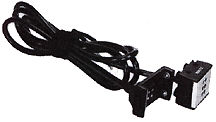 |
M. AC Control Box AC transformer for use with household current. Incorporates a selector switch between single-frame operation and sequential exposure operation, a terminal for the relay cord and a timer for exposures in intervals from 4 frames per second to one frame every 120 sec. Relay Cords 1.2m and 10m Extension cords for remote control; one is 1.2m (3.9ft), the other is 10m (32.8ft). |
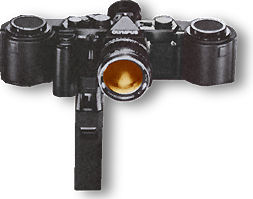 |
250 Bulk Film Back 1 |
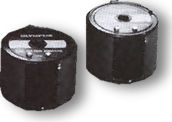 |
250 Film Magazine " ... OLYMPUS 250 FILM BACK1 WITH 35-POF This is an Olympus 250 exposure back with the 35-POF computer attachment made by Miletus Assoc., New Mexico. I think this was made for record keeping and used by the USN. It will work as a long roll back on any OM1 or 2 and maybe with the OM3 & 4 as well. At any rate it's a cool item and if your into OM cameras this might be a great addition to your collection. It would work well for large group photos or sporting advents...." - Michael - |
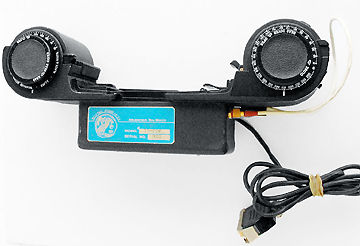 |
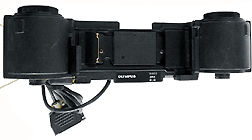 |
Credit: Images courtesy of Mr. Michael Chandler® <Dexcam1@aol.com> where he also operates a popular Ebay Store as well as a website on their own at www.dexterscamera.com Dexter Camera also can be reached by writing to: Dexters Camera 484 E Main St Ventura Ca 93001 USA 805-643-2172. Images copyright © 2003. All rights reserved. |
|
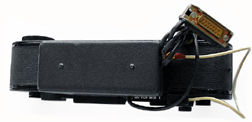 |
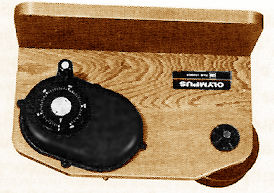 |
250 Bulk Film Loader |
Compartment Case L Partitioned Insert The Compartment Case L is a hard dual purpose shoulder or hand-carried case with two adjustable partitions. Capable of holding the Motor Drive set by use of the optional partitioned insert.
Finder Groups and Units The viewfinder is one of the most important features of a single lens reflex camera. Since every photographic subject is turned into a visual image by means of the f i under, a f i under that is dark or difficult to look through is an obstacle to good photography. However enriched the SLR camera is with a wide range of interchangeable lenses, this SLR cannot be expected to fulfill its essential function without the provision for changing of focusing screens. The OM-2 is provided not only with an electronic shutter, but also with a viewfinder that offers a far brighter, larger image than conventional 35mm SLR cameras. The Finder Group supplements this basic advantage with a comprehensive set of 12 Focusing Screens for a wide variety of applications from photomicrography to astrophotography. Unless the most suitable focusing screen for a given photographic purpose is available, the potentialities of a system camera cannot be utilized. For fast, accurate focusing, the OM System Finder Group offers the unique Varimagni Finder with a magnification selector, the Eyecup 1 that accepts a variety of Dioptric Correction Lenses, Eye coupler, etc.
Varimagni Finde This unique and exclusive unit for the OM System combines the two functions of angle finder and magnifier, incorporating 9 lens elements and a reflector. It fits over the camera's eyepiece, and can be adjusted for individual eyesight.
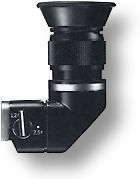 |
Its eyepiece tube is ratable through 360, for use in low level and 90° angled shots. The two-stage, one-touch switching system offers both a 1.2x magnification image covering the whole screen, and a 2.5x enlargement of the central portion for critical focusing. For photomicrographic use, insert the Eye coupler between the camera and Varimagni Finder. |
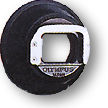 |
 |
Eyecup 1 Attached by sliding over the OM Body eyepiece. With its attached rubber hood it prevents stray light from entering through the eyepiece, an essential requirement in manual light measuring. The Eyecup 1 is provided with a slot for Dioptric Correction Lenses.Connects the Varimagni Finder to the OM Body f or photomicrograph y. I t also ensures full coverage of the bright viewfinder field for use of the Eyecup 1 in conjunction with the Motor Drive 250 Film Back. |
Focusing Screens Interchangeable Focusing Screens are often thought of as a luxury feature in 35mm photography, Yet the Standard Focusing Screens-1 is often inconvenient or difficult to use, and in some circumstances it is quite unsatisfactory. With super-telephoto lenses for instance, the microprism becomes excessively dark. With the high magnifications of macrophotography and photomicrography, it is impossible to focus. The feature of each Focusing Screen is listed at right. The 1-3 and 1-13, suitable for general photography, are particularly advantageous when taking a subject with vertical lines. The 1-5 is ideal for the snap-shooters using a wide angle lens. The 1-4 and 1-7 are designed for super-telephoto lenses and 1-4, 1-11 and 1-12 are for close-ups, macrophotography and photomicrography. The 1-5, 1-6, 1-7 and 1-9 are not used with the exposure meter built in the camera.
|
TYPE |
SCREEN TYPE |
FEATURES |
|
1 -1 |
|
Standard type, suitable for general photography. Fast and accurate focusing is done on the central microprism spot as well as on the surrounding matte area. When a lens with a maximum speed of F5.6 or slower is used, the microprism darkens and focusing must be made on the matte area. The meter needle indicates proper exposures. |
|
1 -2 |
|
Suitable for general photography in conjunction with a standard or telephoto lens. Focusing Is done on the microprism spot as well as on the matte area. When a lens with a maximum speed of F8 or slower is used, the microprism spot darkens. The meter needle indicates proper exposures. |
|
1 -3 |
|
Suitable for general photography ensuring critical focusing, and ideal for photographers who prefer the split-field and coincidence type focusing. When a lens with a maximum speed of F5.6 or slower is used, the split prism darkens. The meter needle indicates proper exposures. |
|
1 -4 |
|
Suitable for general photography and ideal for photographers who prefer a view field free from microprism or split prism and for those who are accustomed to focus using matte area. Also suitable for super telephoto photography and close-up photography in conjunction with macro lenses and Auto Bellows. The meter needle indicates proper exposures. |
|
1-5 |
|
This transparent screen provides an exceptionally bright finder image. Highly suitable for snapshots using wide angle lenses. The lack of matte surface means depth-of-field effects cannot be ascertained. The meter needle does not indicate proper exposures, because its movement varies depending on the lenses used. |
|
1-6 |
|
This screen provides an extremely bright finder image. Focusing is done on the microprism spot. The lack of matte surface means depth of-field effects cannot be ascertained and the meter needle does not indicate proper exposures. |
|
1 -7 |
|
Developed primarily for use with super telephoto lenses, this clear field screen provides an extremely bright finder image. The microprism spot remains bright even with a lens whose maximum speed is F 11. The lack of matte- surface means depth-of-fleld effects cannot be ascertained, the meter needle does not indicate proper exposures. |
|
1 -8 |
|
This screen s ideal for use with super telephoto lenses of 300mm or more in focal length, or for astrophotography. The extreme fineness of the matte surface permits outstanding field definition. More accurate focusing may be achieved by the use of the Varimagni Finder. |
|
1-9 |
|
Designed for use with OLYMPUS fiber optic encloscopes. This condenser type screen without fresnel lens requires no focusing when a special adapter couples the camera with the fiberscope. Exposure is made automatically by the light supply. |
|
1-10 |
|
The grid lines engraved on the all-matte surface are used for vertical and horizontal picture alignment. Though originally designed for architectural photography with the shift lens, it is also suitable for general and super-telephotography, and close-up / macrophotography with macro lenses and Auto Bellows. |
|
1-11 |
|
Highly advantageous for close-up and macrophotography with Auto Bellows and extension tubes. For focusing in low magnification close up photography, use the matte area and in macrophotography greater than life size, use the double cross hairs the same way as with the - 12. The meter needle indicates proper exposures, but depending on the conditions of the specimen, the reading must be compensated for. |
|
1-12 |
|
The transparent screen offers the photographer focusing with an unusually bright finder image. To focus, first correct your diopter using a dioptric correction lens or Varimagni-Finder so that" each line of the double cross hairs can be seen clearly and separately. Then bring the specimen into focus. The meter needle indicates proper exposures, but depending on the specimen's conditions, the reading must be compensated for. |
|
1-13 |
|
Most suitable for normal photography, this screen assures pinpoint focusing. The central split-image range finder is encycled by a microprism collar. Since the outer area has a matte surface, the screen can be used in the same way as the standard 1-1 and 1-3 Screens. When a lens with a maximum speed of F5.6 or slower is used, the prisms darken and the focusing must be made on the matter area. |
|
1-14 |
|
Most suitable for normal photography. The central split-image range finder, encircled by a microprism collar, is inclined 45 degrees to allow easy focusing on subjects with vertical or horizontal lines. When a lens with a maximum speed of F5.6 or slower is used, the prisms darken and focusing must be made on the matte area. The meter needle gives correct light readings. |
Dioptric Correction Lens 1 |
Flash Photo Group Flash is your own private "sun" when you take pictures at night, indoors, or daylight fill-in. At the moment of flash, you can even catch the movement of subjects that your own eyes are unable to follow.
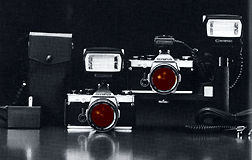 |
At present the OM System Flash photo Group renders a choice of 4 different flash units, including the Quick Auto 300, etc.The Quick Auto 300 is the heart of the Group. Small and lightweight, it nevertheless offers high performance ó a maximum ASA 100 (in meters) guide number 34 with an angle wide enough to cover the picture area of a 24mm super wide-angle lens. |
Beside the 3 automatic settings, 2 manual settings are also available in a single dial operation.
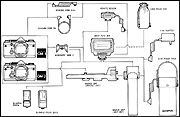 |
During manual operation, flash intensity is freely controllable for fill-in lighting in daylight scenes, while the use of the Remote Sensor and Bounce Grip units allows automatic bounce flash. <<--- PDF Format (59k) |
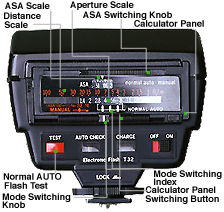 |
Flash Units For other OM flash units produced by Olympus such as T20, T32 and T45, go to the specific site for Flash. The first TTL flash in the world was a Olympus Quick Auto 310 which is dedicated for the original OM-2 camera which closely resembled with the Quick Auto 300 flash shown below here.Whether new or used, here is something that can help you: Instruction Manual for Olympus T32 TTL flash. But since Olympus has eventually redesigned the Quick Auto 310 later with an upgrade T32 flash (and a smaller guide number TTL-flash of T20); so does the OM-2n. |
 |
It may be too complicated here to discuss the flash issues, but since all those are essentially very old models and may not even get access to them, you are advised to concentrate on the few modern flash that still works flawlessly with all these OM models until now. |
With a guide
number of 34 (ASA 100, meters), this is the most powerful! flash unit generally available,
offering a wide coverage to give even illumination throughout the picture area of
a 24mm super wide-angle lens. It provides fully automatic flash capability at f4,
f5.6 & f8. Hl and LOW manual settings are possible. Also incorporates
an auto check lamp. Working off 4 penlight batteries with any direct contact camera.
Can be used together with the Bounce Grip, permitting a choice of various power sources.
|
Previous | Next | 8/9
| Back | to Index Page of OM2(n) Instruction Manual
| Back |
to Index Page of OM2(n)
| Back |
to Main Index Page of OM1(n) & OM2(n)
Olympus
OM-2(n):
Camera
Operations
(9
Parts)
| Other
Issues
(5
Parts)
Specifications: HTML | PDF (48k) Main Reference
Map: HTML | PDF (203k)
Olympus
OM-2 SP:
Camera
Operations
| Other Issues
Specifications: HTML | PDF | Main Reference Map: HTML | PDF
Olympus
OM-1(n): Camera Operations (6 Parts) | Other
Issues
(5
Parts)
Specifications: HTML | PDF | Main Reference Map: HTML | PDF (217k)
Shared
Resources:
Supplementary
articles:
TTL
Metering,
Depth
of Field,
Shutter
Speed
& Aperture
Motor
Drive and Power Winder: Main Index Page (4 Parts)
Motor Drive 1 | Motor
Drive 2
| Winder 1 | Winder
2
Flash Photography: Main Index Page (4 Parts)
T45 | T32 | T20 | F280 | S20 | Qucik AUTO 310 | QA300,
200, 200S
Macro-Photography: Main Index Page (3 Parts)
Macro Flash Units: T10 Ring Flash, T28 Twin, T28 Single,
T8 Ring Flash
Accessories: Databack 1-4 | Screens | Finder Accessory | Remote | Cases
Zuiko
Lenses: Construction in progress..
Glossary of Photography
A good external source for used Instruction
Manuals
for various OM SLRs and Accessories.
| Message Board | for
your favourite
Olympus
OM-1(n)
and OM-2(n)
series
SLR Camera models
| Message Board | for your Zuiko Optics in a shared environment
| Message Board |Specifically for Dispose or Looking for OM Photographic Equipment
Home - Photography in Malaysia |
Copyright © 2000. leofoo ®. MIR Web Development Team.
Site
& Message Board Maintainers:
Mr. Simon Evans <ruralwales@yahoo.com>; Mr. Rick Oleson
<rick_oleson@yahoo.com>; Mark Dapoz
<md@dementia.org>;Mr. Rick Oleson
<rick_oleson@yahoo.com>; Mr. Bruce
hamm <bhamm@magma,ca>
Credit: My old time buddy,
Ahmad
Ikram,
Dr of Rubber Research Institute (RRI), Malaysia
who shares the same passion with me and also lending his OM-1n, OM-4 and the Motor
Drive 1 to me for preparing some images in this site; Mark Dapoz <md@dementia.org>for reminding
some broken links;
Mr Poon of Foto Poon, Ipoh, Mr Richard, Ampang Park, Mr Lim
and Miss Jenny of Foto Edar for their generosity for their OM1(n), OM2n camera
and some Zuiko lenses. Mr Hans van Veluwen for mistakenly using
some content earlier from his OM website; J Sorensen
for providing some useful images to rectify some technical "flaws"; Mr
Gen Holst for helping during the early stages of development of this OM site;
Mr KKLow for some of his earlier images on the OM-1appeared in this website;
Miss Wati and Mirza for helping me
to convert this Operation Manual into a HTML format. Mr MCLau for rectifying
some mistakes made on the earlier preview sites. Site created 'unfortunately' again
with a PowerMac. A personal tribute to the
creator of the OM system and also a site dedicated to all the fans of Olympuses and
Zuiko Optics worldwide. Some of the content
and images appeared in this site were scanned from OM official marketing leaflets,
brochures and instruction manual(s) for educational purposes. Olympus is a registered
tradename of Olympus Optical Inc., Japan.
